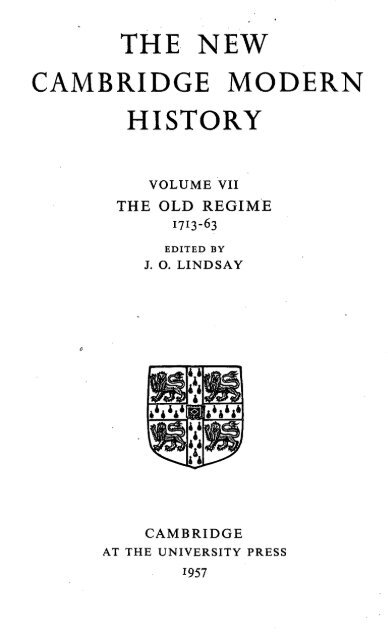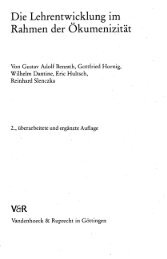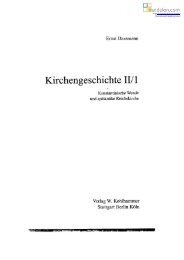THE NEW CAMBRIDGE MODERN HISTORY
THE NEW CAMBRIDGE MODERN HISTORY
THE NEW CAMBRIDGE MODERN HISTORY
Create successful ePaper yourself
Turn your PDF publications into a flip-book with our unique Google optimized e-Paper software.
<strong>THE</strong> <strong>NEW</strong><br />
<strong>CAMBRIDGE</strong> <strong>MODERN</strong><br />
<strong>HISTORY</strong><br />
VOLUME VII<br />
<strong>THE</strong> OLD REGIME<br />
1713-63<br />
EDITED BY<br />
J. O. LINDSAY<br />
<strong>CAMBRIDGE</strong><br />
AT <strong>THE</strong> UNIVERSITY PRESS<br />
1957
CONTENTS .<br />
CHAPTER I<br />
INTRODUCTORY SUMMARY {page i)<br />
By J. O. LINDSAY, Fellow ofGirton College and Lecturer in History<br />
in the University of Cambridge<br />
CHAPTER II<br />
<strong>THE</strong> GROWTH OF OVERSEAS COMMERCE AND<br />
EUROPEAN MANUFACTURE<br />
By C. H. WILSON, Fellow of Jesus College and Lecturer in History<br />
in the University of Cambridge<br />
Changes in world trade by 1713; decline of Dutch . . . . . page 27<br />
Commercial expansion of England and France 28<br />
Beginnings of English industrial revolution 29-30<br />
Financing of industrial expansion 31-2<br />
English mercantilist regulation of overseas trade 32<br />
English naval strength , . 33<br />
French commercial expansion 33<br />
Fundamental weakness of French trade 34-5<br />
Anglo-French commercial rivalry 36<br />
Commercial rivalries in Atlantic 37-9<br />
Commercial rivalries in India 39<br />
Dutch strength in south-east Asia 40<br />
Commercial rivalries in Mediterranean 41<br />
Trade inside Europe 42<br />
Gradual decline of Dutch trade . . 42-3<br />
Holland remains financial centre 43-4<br />
Foreign trade relied on naval strength 45<br />
Economic theories 46<br />
Signs of change in theories 47-9<br />
CHAPTER III<br />
<strong>THE</strong> SOCIAL CLASSES AND <strong>THE</strong> FOUNDATIONS<br />
OF <strong>THE</strong> STATES<br />
By J. O. LINDSAY<br />
Eighteenth-century society apparently aristocratic and French . . . . 50<br />
Aristocratic character supported by Church 51<br />
Society in fact less uniform 51<br />
Differences in relations of nobles and peasants in different countries . . . 52<br />
France 53<br />
Central and eastern Europe 53-4<br />
Political powers of nobles varied from country to country . . . . . 55<br />
Useless court nobility of France, Spain 55<br />
Serving nobility of Prussia, Russia 56<br />
Politically powerful nobles of Hungary 56'<br />
Poland, Sweden 57<br />
England 58<br />
V
CONTENTS<br />
Aristocratic nature of society undermined by growth of middle class . . -page 58<br />
Mercantile middle class of England 58-9<br />
Urban patriciate Italy, Switzerland, German cities, Holland . . . . 59-60<br />
Status of professional middle class . . 61<br />
Bureaucratic middle class of eastern Europe 62<br />
Society not exclusively French 63<br />
Influence of Italy 63<br />
Germany 64<br />
World outside Europe 65<br />
CHAPTER IV<br />
<strong>THE</strong> VISUAL ARTS AND IMAGINATIVE<br />
LITERATURE<br />
By PROFESSOR SIR ALBERT RICH ARD SON, Past President of the Royal Academy<br />
Art and literature theoretically classical and derivative 66<br />
Architecture, classical transformed into baroque 66-7<br />
Early emergence of Gothic revival 69<br />
Originality of English town planning 70<br />
New social environment of coffee houses 70<br />
New journalism 71<br />
Natural treatment of contemporary life 72<br />
Poetry both classical and original 73<br />
Originality of satire and travel books 73<br />
Need for new genre, degeneracy of stage 74<br />
Rise of the novel 75-6<br />
Romantic poetry 76<br />
Art shows same development as literature 77<br />
Classical French painting 77<br />
Baroque painting 77-8<br />
Greater naturalness of French painting 78<br />
French sculpture remains classical 78<br />
English painting of real life 79<br />
Theories about art 80<br />
Influence of illustrated books on architecture and art 81-4<br />
CHAPTER V<br />
<strong>THE</strong> ENLIGHTENMENT<br />
By A. COBBAN, Professor of History, University College, London<br />
Enlightenment begins before 1700 85<br />
Early criticism of religion . . . 85-6<br />
Later criticism of religion in France and England 86-7<br />
Superficiality of eighteenth-century philosophy 87<br />
Science the new evangel 88<br />
Importance of Newton 88-9<br />
Popularity of natural science 89<br />
Backwardness of chemistry 90<br />
Period of diffusion rather than advance 91<br />
Psychology of Locke ' 91-2<br />
Social sciences 92<br />
vi
CONTENTS<br />
Great importance of history page 93<br />
Vico 94<br />
Theoretical presuppositions of philosophers 95<br />
Sensational psychology • 95-6<br />
Hedonism and re-orientation of moral ideas 97<br />
Individual hedonism and the claims of society 98<br />
Political ideas of secondary importance 99<br />
German ideas of natural law 100<br />
English and French political ideas 101-2<br />
Economic ideas 103<br />
Optimism of the Enlightenment 104-5<br />
Belief in possibility of reform 105<br />
Diffusion of ideas of the Enlightenment 105-6<br />
Journals, dictionaries, the Encyclopaedia 106<br />
Influence of Paris salons 106-7<br />
Backwardness of universities 107<br />
Educational experiments 108<br />
Religion still very strong 108-9<br />
Protestant mysticism 109<br />
M;taphysical thinkers no<br />
Emergence of romanticism in imaginative literature no-n<br />
Small area influenced by Enlightenment 111<br />
CHAPTER VI<br />
RELIGION<br />
By R. W. GREAVES, Reader in History in the University of London<br />
Decline of papal political influence 113<br />
The personalities of the popes 113<br />
Difficulties confronting the popes 114<br />
The renewed Jansenist controversy 114<br />
Unigenitus 114-16<br />
Last phase of Jansenist struggle 116<br />
Modification of Unigenitus by Ex Omnibus 117<br />
Similarities between Jansenists and philosophers 117-18<br />
Growth of historical criticism 118<br />
Reform of breviary and missal 118-19<br />
Strength of secular influences 119<br />
VanEspen 119<br />
Giannoni's criticism of ecclesiastical power 120<br />
Von Hontheim's attack on Papacy . . 121<br />
Declining power of the Jesuits 122<br />
Failure of Jesuits, China 123<br />
Jesuits expelled from Portugal 123-5<br />
Suppression of Jesuits in France 125<br />
Jesuits overthrown not by 'philosophers' but by anti-papal Christians . . . 126<br />
Protestantism in England 126<br />
The Archbishop of Canterbury 126-7<br />
Political character of English episcopacy 127-8<br />
The Dissenters 128<br />
Relations of Church and State in England 129<br />
Lutheran and Reformed churches in Germany 130<br />
vii
CONTENTS<br />
Pietism and rationalism both anti-clerical page 131<br />
Rationalism 132<br />
Projects of Christian reunion 133<br />
Archbishop Wake's projects for union 133-4<br />
The traditions of the Church of England 135-6<br />
Growth of Methodism 136-9<br />
Evangelical awakening of Church of England 139-40<br />
CHAPTER VII<br />
MONARCHY AND ADMINISTRATION<br />
1. European practice, by J. O. LINDSAY<br />
2. The English inspiration, by W. R. BROCK, Fellow of Selwyn College and<br />
Lecturer in History in the University of Cambridge<br />
I. EUROPEAN PRACTICE<br />
Contemporary writers on political thought 141<br />
Prevalence of absolute monarchy 141<br />
Difference between absolutism in different countries 142-3<br />
Improvement in central governmental institutions:<br />
Sweden 144<br />
Russia 145<br />
France 145-6<br />
England 146<br />
Spain 147<br />
Prussia 148<br />
Habsburg dominions 149<br />
Financial methods still chaotic 150<br />
Indirect taxes in Spain 150<br />
Direct taxes 151<br />
Beginnings of a National Debt 152<br />
Administration of justice 152<br />
Increased efficiency of provincial administration 153<br />
Intendants in France 153<br />
lntendants in Spain 154<br />
Prussian provincial government 155<br />
Austrian provincial government 155-6<br />
Hungarian provincial government 157<br />
English J.P.'s 157-8<br />
Theories of government, cameralism 158-60<br />
Exceptions to absolute monarchy, Poland 160<br />
2. <strong>THE</strong> ENGLISH INSPIRATION<br />
Ideas about English liberty 160-2<br />
CHAPTER VIII<br />
<strong>THE</strong> ARMED FORCES AND <strong>THE</strong> ART OF WAR<br />
By the late ERIC ROBSON, Senior Lecturer in History<br />
in the University of Manchester<br />
Eighteenth-century warfare governed by convention 163<br />
Emphasis on manreuvre rather than battle 164<br />
viii
CONTENTS<br />
Strategy primarily defensive page 164-5<br />
Limited objectives of eighteenth-century wars 165<br />
Many wars were purely dynastic . 166<br />
Conventions of siege warfare 166-8<br />
Armies'lack of mobility 168<br />
Strict discipline necessary because of tactical methods 169<br />
Tactical formations elaborate and slow. . 169-70<br />
Naval tactics equally conventional . 170<br />
Winter campaigns infrequent 170-1<br />
Formal character of warfare made few demands on officers 171<br />
Strategic methods of Frederick the Great characteristic of his age . . . 171-2<br />
Tactics of Frederick the Great original. . . 172-3<br />
British reliance on naval supremacy 173<br />
British military methods unsuited to colonial warfare 173<br />
Gradual changes in British methods on land and at sea 174<br />
Armies relatively small, wars lacking in passion 174<br />
Armies recruited from nobles and vagabonds 175<br />
Composition of armies necessitated harsh discipline 175-6<br />
Inadequate evidence of conditions of other ranks 176-7<br />
•julf between officers and men 177<br />
Frederick II's care for his men 178<br />
Growing consideration for men in British navy . . . • . . . . 178<br />
Development of conscription 178-9<br />
Use made of nobility in Prussian army 179<br />
Position of peasants in Prussian army 179-80<br />
Savage Prussian discipline 180-1<br />
Inadequacy of noble French military commanders 181-2<br />
French naval commanders more able 183<br />
French naval conscription 183<br />
Methods of recruiting for British army and navy 183-4<br />
Purchase of British commissions 185-<br />
Influence and promotion 186<br />
No purchase of naval commissions 187<br />
Conditions of promotion in the navy 188-9<br />
CHAPTER IX<br />
INTERNATIONAL RELATIONS<br />
By J. O. LINDSAY<br />
Peace settlement, 1713-14 191<br />
Renunciation of Philip V to French throne 191<br />
Establishment of'barriers' 191<br />
English acquisition of naval bases 192<br />
English commercial benefits 192<br />
System of alliances after 1713 192-3<br />
Death of Louis XIV 193<br />
French reasons for desiring alliance with England 194<br />
England influenced by developments in Baltic to ally with France . . . 195<br />
Value to England of French alliance 195<br />
Diplomatic storm centres, Baltic and Mediterranean 195<br />
Baltic crisis of 1716 196<br />
ix
CONTENTS<br />
Mediterranean crisis provoked by Elizabeth Farnese page 196-7<br />
Expeditions organised by Alberoni 197<br />
Quadruple alliance 197<br />
Success of Anglo-French diplomacy, 1719-21 198-9<br />
Congress of Cambrai 199<br />
Changes of personnel in France 200<br />
Spanish approach to the Emperor 200-1<br />
Mission of Ripperda, 1725 201<br />
Failure of Ripperda's policy 202<br />
Treaty of Seville, 1729 . . ' 202<br />
Don Carlos in north Italy 202<br />
Anglo-French diplomacy in north-east Europe 203<br />
Holstein-Gottorp question 203<br />
British naval expedition to Baltic, 1726 203<br />
Emergence of Russia and Prussia as Great Powers 203-4<br />
War of Polish Succession 204<br />
English neutrality 205<br />
Breakdown of Anglo-French Alliance 205<br />
Growth of Russian power 205<br />
War of Austrian Succession, 1740 206<br />
Friction between England and Spain 206<br />
Share of South Sea Bubble in causing war of 1739 207-9<br />
French diplomacy 210<br />
Peace of Aix-la-Chapelle 210<br />
Diplomatic Revolution 211<br />
Outbreak of Seven Years War 211<br />
Peace of Paris, 1763 212-13<br />
CHAPTER X<br />
<strong>THE</strong> DECLINE OF DIVINE-RIGHT MONARCHY<br />
IN FRANCE<br />
By A. COBBAN<br />
Divine-Right monarchy in France still strong 214<br />
France best example of decline of absolute monarchy 215<br />
Weakness of French absolutism, administrative confusion 215<br />
Survival of independent enclaves 215<br />
Lack of unified fiscal system 216<br />
Decay of effective local self government 216<br />
Limitations in powers of the intendant 216-17<br />
Weakness of central government 217<br />
Councils 217-18<br />
Secretaries of State 218<br />
Difficulty of enforcing royal will 219<br />
Crown as symbol of the State 219<br />
Incapacity of Louis for the role of absolute monarch 220<br />
No other authority to share burden of government 220<br />
Policy of regent 220-1<br />
Financial problems 221-2<br />
Financial reform of Law 223<br />
Results of Law's experiment 223<br />
x
CONTENTS<br />
Failure of regent's administrative reforms page 224<br />
Foreign policy of the regent 224<br />
Duke of Bourbon in power 224<br />
Fleury's administration 224<br />
Pacific foreign policy of Fleury . 225<br />
Louis XV in control of policy . 225-6<br />
Character of Louis XV . . . 226<br />
Lack of consistent foreign policy 227-8<br />
Diplomatic Revolution and emergence of Choiseul 228<br />
Weakness of internal policy 228-9<br />
Religious disputes 229<br />
Rkhirisme among parish clergy 229<br />
Jansenist controversy 230<br />
Religious policy of the regent 230<br />
Revived Jansenist controversy, 1750 231<br />
Persecution of the Huguenots . 232<br />
Spread of anti-religious spirit . . 233<br />
Suppression of the Jesuits 233<br />
Financial difficulties of the Crown only a symptom 234<br />
Social structure essential cause of collapse of Divine-Right monarchy . . . 235<br />
Complex characteristics of the nobles and of bourgeoisie 236<br />
Economic developments disrupting social structure 237<br />
Industrial developments 237-8<br />
Economic weaknesses 238<br />
CHAPTER XI<br />
ENGLAND<br />
By W. R. BROCK<br />
Economic conditions 241<br />
Exceptionally low rates of interest 242<br />
Bad communications 242<br />
Exports of great value 242-3<br />
Rural conditions ~~-% . 243<br />
The country gentleman j . 243-4<br />
Increasing political power of great landowners 244<br />
Borough politics 245<br />
Role of Church of England 245-6<br />
Dissenters 246<br />
Party alignments in 1714 246<br />
Triumph of Whigs 247<br />
Failure of Jacobite rising 1715 247-8<br />
Religious policy of Whigs to Dissenters 248 :<br />
Convocation silenced 249<br />
Dissensions among the Whig leaders 249<br />
Ascendancy of Sunderland and Stanhope, 1717 249-50<br />
South Sea Bubble 250-1<br />
Political results of the Bubble, rise of Walpole 251<br />
Character and achievement of Walpole 251-2<br />
Growing opposition to Walpole 253<br />
xi
CONTENTS<br />
Walpole's successors, Carteret and Pelham . page 253-4<br />
Jacobite rising of 1745 254<br />
Rise of Pitt 255<br />
Accession of George III 255<br />
Fall of Newcastle 256<br />
Powers of Crown in eighteenth century 256-7<br />
Growth of cabinet government 258-9<br />
Ministers of the Crown 259<br />
Central bureaucracy 259-60<br />
Local government 260<br />
House of Lords 260<br />
House of Commons 260<br />
Influence and patronage 261-2<br />
Judicial system 262-3<br />
Nature of English liberty 264<br />
Libel and sedition 264<br />
Younger sons of gentry entered professions 265<br />
Conditions of poor 266<br />
Industrial development 267<br />
CHAPTER XII<br />
<strong>THE</strong> WESTERN MEDITERRANEAN AND ITALY<br />
By J. O. LINDSAY<br />
Diplomatic initiative gained for Spain 269<br />
Spain in state of economic collapse at end of seventeenth century . . . 269-71<br />
Economic reform hampered by Church 271-3<br />
Nobility indifferent to reform 273-5<br />
Bourgeoisie few and apathetic 275<br />
Economic reforms of army 276<br />
Alberoni's reforms 277<br />
Ripperda's effort to restore prosperity to Spain 278<br />
Reforms of Patiflo 278<br />
Attractive appearance of Italy in eighteenth century . . . . . . 280<br />
Reality less attractive, much poverty and oppression 281<br />
Changes in political maps of Italy, 1713-48 282<br />
Effects of these changes, reforms in Milan and Naples 284<br />
Rome 284<br />
Spanish policy under Ferdinand VI 285<br />
Carvajal's foreign policy 285<br />
Industrial reforms 286<br />
Ensenada's economic reforms 287<br />
Charles III , 287<br />
Portugal unstirred by reform till 1750 / 288<br />
Economic conditions 288<br />
Portuguese monarchy 289<br />
Pombal's attack on the Jesuits 290<br />
Pombal's economic reforms '. . . . . 291<br />
Xll
CONTENTS<br />
CHAPTER XIII<br />
<strong>THE</strong> ORGANISATION AND RISE OF PRUSSIA<br />
By W. H. BRUFORD, Fellow of St John's College and<br />
Professor of German in the University of Cambridge<br />
German historians' treatment of rise of Prussia page 292<br />
Geographical character of Hohenzollern possessions 292<br />
Gradual unification of Hohenzollern territories 293<br />
Economic weakness 293<br />
Effects of Thirty Years War 294<br />
Creation of standing army by Great Elector and provincial Estates overcome . 294<br />
Frederick William I's contribution to growth of strong monarchy . . . 294-5<br />
Development of the army 295-6<br />
Efforts to increase royal revenue 296<br />
Exploitation of domain lands 296-7<br />
Other taxes 297-8<br />
Reform of civic administration 299<br />
Encouragement of immigration 302<br />
Reform of administration 303<br />
Combination of domain and excise officials 304<br />
Creation of General Directory 304-5<br />
Religious toleration 306<br />
Education 306<br />
Administration of justice 306<br />
Education of the Crown Prince 307-8<br />
Character and abilities of Frederick the Great 308-9<br />
Aggressive policy of Frederick the Great 310-n<br />
Political philosophy of Frederick the Great 310-n<br />
Frederick's reforms after 1756 311<br />
Complete centralisation of government 312<br />
Objects of this system 312<br />
Attempts to improve the governmental system 312-13<br />
Industrial reform 315<br />
Trade 316<br />
Reform of the judicial system 317<br />
CHAPTER XIV<br />
RUSSIA<br />
By IAN YOUNG, Lecturer in Slavonic Studies in the University of Cambridge<br />
New epoch as from 1709 318<br />
Economic conditions, chief wealth forest products 318<br />
Development of iron industry . . 1 318<br />
Other industrial developments . • /• 319<br />
Labour plentiful ' 319<br />
Communications 319<br />
Export trade . . . . . . 320<br />
Peter's fiscal reforms . 320<br />
Population and social structure 321<br />
Conditions of the peasants 321-2<br />
The nobility 322-3<br />
xiii
CONTENTS<br />
Re-organisation of the army page 323<br />
Reform of administrative institutions 323<br />
Reform of provincial administration 324<br />
Judicial system 324-5<br />
The Church 325<br />
Reforms of education 325-6<br />
Reign of Catherine I 327<br />
Peter II, negotiations on behalf of Anna 328<br />
Anna's accession, administrative reform 329<br />
Concessions to the nobility, Volynsky 330<br />
Ivan VI, intrigues on behalf of Elizabeth 331<br />
Elizabeth's accession, Diplomatic Revolution 332<br />
Seven Years War, Bestuzhev's intrigues 333<br />
Peter III, further concessions to the nobility 334<br />
Orlov's revolution, the Church 335<br />
Education and cultural life 336<br />
Income of the nobility 337<br />
Shuvalov's financial and commercial reforms 338<br />
CHAPTER XV<br />
SCANDINAVIA AND <strong>THE</strong> BALTIC<br />
By R. M. HATTON, Lecturer in Economic and Political History<br />
at the London School of Economics<br />
Settlement after the Great Northern War 339-40<br />
Benevolent absolutism of the Oldenburgs 341<br />
Agriculture and land reform 342-3<br />
Policy of making Denmark and Norway economically complementary . . . 344<br />
Mercantilistic communal policy 344-5<br />
Danish foreign policy 345<br />
Holstein-Gottorp claims in Slesvig-Holstein • . 345-7<br />
Crisis of 1723-7 347<br />
Danish foreign policy, alliance with France 348<br />
Danish efforts to secure succession to Swedish throne for Danish prince . . 348<br />
Tsar Peter Ill's claim to Slesvig-Holstein, 1760 349<br />
Settlement of Slesvig-Holstein 350<br />
Reduction of royal power hi Sweden on death of Charles XII . . . . 350-1<br />
Ulrika Eleonora's election and abdication 351<br />
Swedish Constitution of 1720 352<br />
Composition and powers of the Four Estates '. . 353-4<br />
Swedish political parties . 355<br />
Brief ascendancy of Hessian party, 1720-1 355<br />
Holstein party in power, 1723-6 355<br />
Ascendancy of Count Horn and the'Caps' 355<br />
Hats'period of power, 1738-65 356-7<br />
Sweden's part in the War of the Austrian Succession 358<br />
Russian occupation of Finland 359<br />
Charles Peter Ulrich of Holstein-Gottorp refuses Swedish succession . . . . 360<br />
Sweden's dependence of Russia after Treaty of Abo 361<br />
Party struggle of Hats and Caps 362<br />
Further limitation of the monarchy; the Seven Years War 363<br />
Election campaign of 1764-5 364<br />
xiv
CONTENTS<br />
CHAPTER XVI<br />
POLAND UNDER <strong>THE</strong> SAXON KINGS<br />
By L. R. LEWITTER, Fellow of Christ's College and Lecturer in Polish<br />
in the University of Cambridge<br />
Political institutions page 365-6<br />
Administration of justice 367<br />
Backward condition of agriculture 368<br />
Trade and industry 369<br />
Education and intellectual life 370-1<br />
Rivalry for Polish throne; concluded, 1717 372<br />
Economic aspect of the settlement 372-3<br />
Russian domination after the Treaty of Warsaw, 1717 373<br />
Anti-Russian foreign policy of Augustus II 373-4<br />
Persecution of Protestants 374<br />
Religious crisis at Thorn, 1724 375-6<br />
Attempts to secure Saxon succession 377-8<br />
Czartoryskis and Potockis 378<br />
Succession of Augustus III 379<br />
War of the Polish Succession 379-8o<br />
Settlement of the War of the Polish Succession 381<br />
Political degeneration under Augustus III 382-3<br />
Waning influence of the Czartoryskis 384<br />
The Seven Years War 385-6<br />
Foreign policy 387-8<br />
Failure of the political system 389<br />
Russian and Prussian territorial claims 390<br />
CHAPTER XVII<br />
<strong>THE</strong> HABSBURG DOMINIONS<br />
By C. A. MACARTNEY, Fellow of All Souls, Oxford<br />
Conclusion of the War of the Spanish Succession 391<br />
Hungary and the Treaty of Szatmdr 391<br />
Charles VI's conciliation of Hungary < 392<br />
The female succession in Austria 393<br />
Hungarian support of Charles's daughter 393-4<br />
War with Turkey, 1716-18 394<br />
Charles joins Quadruple Alliance 394<br />
Female succession confirmed in Hungary 395<br />
Rights of Hungary recognised by Charles VI 396<br />
Pragmatic Sanction enacted 397<br />
Friction over the Ostend Company 397<br />
War of the Polish Succession; marriage of Maria Theresa 398<br />
Cultural life 399<br />
Administrative institutions 400<br />
Austrian trade to East Indies; power of Church in Austria and Bohemia . . 401<br />
Weakness of Czech nationalism; Habsburg policy of preserving territorial division<br />
in Hungary 402<br />
XV
CONTENTS<br />
Subordination of Hungary to Austria; survival of some Hungarian independence page 402-3<br />
Habsburg support for Roman Catholicism in Hungary 403<br />
The national pride of the nobility • . . . 404<br />
Growth of population 405<br />
Increase in proportion of non-Magyar people 405<br />
Predominantly agricultural character 406<br />
Turkish war 407<br />
Unsuccessful Peace of Belgrade 408<br />
Maria Theresa's accession; the Pragmatic Sanction repudiated . . . . 408<br />
Maria Theresa's concessions to Hungary 409<br />
Hungarian support for the Pragmatic Sanction 409<br />
Ultimate retention of throne by Maria Theresa, 1748 410<br />
Maria Theresa's reforms after 1748 410<br />
Military reforms; Lombardy and the Netherlands 411<br />
Maria Theresa's treatment of Hungary , . . 411-12<br />
Obstacles in way of reform 412<br />
Administrative and judicial reforms; Haugwitz . . . . . . . 412-14<br />
Foreign policy after Aix-la-Chapelle 415<br />
CHAPTER XVIII<br />
<strong>THE</strong> WAR OF <strong>THE</strong> AUSTRIAN SUCCESSION<br />
By MARK A. THOMSON, Professor of Modern History<br />
in the University of London<br />
Diplomatic origins 416<br />
Prussian invasion of Silesia 417<br />
British and Russian reactions 418<br />
French support for Charles Albert of Bavaria 419<br />
Prussian victory over Austrians at Mollwitz 419<br />
Prussia's uneasy alliance with France and Bavaria 419<br />
Convention of Klein Schnellendorf between Austria and Prussia . . . . 420<br />
Election of Charles Albert as Emperor 421<br />
French military reverses . . . 421<br />
Frederick's desire for peace, diplomatic schemes of Carteret for accommodation<br />
between Austria and Prussia 422<br />
Dutch non-intervention, preliminaries of Breslau end Austro-Prussian War . . 423<br />
French retreat from Bohemia 424<br />
Austrian strategy in Germany weakened by Spanish intervention in Italy . . 424-6<br />
French policy under personal direction of Louis XV, British victory at Dettingen 426-7<br />
Diplomacy of Carteret 428<br />
Treaty of Worms, 1743 429<br />
George II discredited, naval battle off Toulon 430<br />
French invasion of the Netherlands, prussian invasion of Bohemia . . . 431<br />
Prussian invasion of Saxony; Treaty of Dresden, 1745 432<br />
British and Dutch defeats, Franco-Spanish invasion of Sardinia . . . . 433<br />
Franco-Spanish armies repulsed 434<br />
British naval superiority, French victories in Dutch Flanders . . . . 435<br />
Preliminary peace negotiations 436<br />
Treaty of Aix-la-Chapelle 437-9<br />
XVI
CONTENTS<br />
CHAPTER XIX<br />
<strong>THE</strong> DIPLOMATIC REVOLUTION<br />
By D. B. HORN, Professor in History in the University of Edinburgh<br />
Signs of strain in the Anglo-Austrian alliance page 440<br />
Kaunitz's plan for a French alliance 441-2<br />
Britain's need for Austrian help increased by threats of colonial conflict . . 442<br />
Austria's terms become stiffer 443<br />
Austrian overtures to France, negotiations between Starhemberg and Bernis . 444-5<br />
Anglo-Prussian relations 446-7<br />
British convention with Russia, 1755 447-8<br />
Reactions of Prussia to Anglo-Russian agreement . . . . . . 448<br />
Convention of Westminster (1756) befween England and Prussia . . . . 449<br />
French reactions 450<br />
Austrian reactions 451-2<br />
First Treaty of Versailles between France and Austria 453-5<br />
Austro-Russian relations 456-9<br />
Failure of Newcastle's foreign policy 460<br />
Final breach between France and Prussia 461<br />
Connexion between the Diplomatic Revolution and the outbreak of the Seven<br />
Years War 462-4<br />
CHAPTER XX<br />
<strong>THE</strong> SEVEN YEARS WAR<br />
By ERIC ROBSON<br />
Interconnexion of continental and colonial rivalries 465<br />
Geographical and political conditions affecting Prussia. . . . . . 465<br />
British obligations to Prussia 466<br />
Pitt's gradual conversion to value of continuing operations on the Continent . 467<br />
Frederick's masterly strategy . 468<br />
Defeat and occupation of Saxony by Frederick II 469<br />
French success culminates in Convention of Kloster-Seven, Russian and Swedish<br />
attacks on Prussia 470<br />
Prussian victories at Rossbach and Leuthen 471-2<br />
Britain recovers the position in western Germany, Army of Observation, Prussian<br />
invasion of Moravia 473<br />
Austrian campaigns in Saxony and Silesia, 1758 474<br />
Russian victories, French advance into Westphalia 475<br />
Plan to invade England, rights of neutrals 476<br />
British privateers; campaigns of 1760 477<br />
Military stalemate; peace with Russia 478<br />
Peace negotiations in the West 479<br />
Britain witholds Frederick's subsidy . . 480<br />
Breach between Britain and Prussia . . 481<br />
Family compact 482<br />
Treaty of Paris 483<br />
Treaty of Hubertusburg 484<br />
Effect of the war on Prussian economy . . . 484-5<br />
Results of the war for Britain and France 485-6<br />
xvii
CONTENTS<br />
CHAPTER XXI<br />
<strong>THE</strong> DEVELOPMENT OF <strong>THE</strong> AMERICAN<br />
COMMUNITIES<br />
i. Latin America, by J. H. PARRY, Principal of the University College,<br />
Ibadan, Nigeria<br />
2. North America, by FRANK THISTLETHWAITE, Fellow of St John's College<br />
and Lecturer in History in the University of Cambridge<br />
I. LATIN AMERICA<br />
Administrative incompetence in Spanish America page 487-8<br />
Defence; sale of administrative offices 489<br />
Colonial administration; corregidores 490<br />
Social structure, Creole resentment of Spanish misgovernment . . . . 491<br />
Beginnings of Bourbon reform, enactments against the Church . . . . 492<br />
Reform of the coinage; silver mining 493<br />
Regulation of trade; breakdown of the convoy system 494<br />
Trading companies 495<br />
Creoles gain nothing by the reforms 495<br />
Grouping of administrative units 495-6<br />
Jesuit missions 497<br />
Brazil, reforms of Pombal 498<br />
Visual arts, intellectual life 499<br />
2. NORTH AMERICA<br />
Spread of European immigration and settlement 500-2<br />
Expansion by colonists as well as immigrants 502<br />
Plantation, colonies' expansion aided by new crops of rice and indigo . . . . 502-3<br />
Foundation of Georgia 503<br />
Cleavage between older and newer settlements intensified by system of land holding 504-5<br />
Friction over home government's prohibition of colonial industry . . . 505<br />
Problems of credit and prices intensify resentment of back country farmers . . 506<br />
Religious revivalism encouraged by spread of settlement 507-8<br />
Many tensions within colonial society 508<br />
Social structure, simplicity and poverty of hinterland society . . . . 510<br />
Royal government identified with eastern oligarchy by farmers of the hinterland . 510-11<br />
French expansion 511<br />
Economy based on fur and fish 512<br />
Trading posts; administration; the Church 513<br />
CHAPTER XXII<br />
RIVALRIES IN AMERICA<br />
1. The Caribbean, by J. H. PARRY<br />
2. The North American Continent, by FRANK THISTLETHWAITE<br />
I. <strong>THE</strong> CARIBBEAN<br />
Claim of trade monopoly by Spain 514<br />
Relations between Spain and the South Sea Company 515-17<br />
War of Jenkins'Ear 518-19<br />
Anglo-French warfare, 1744-8 519-20<br />
xviii
CONTENTS<br />
Treaty of Aix-la-Chapelle . page 520-21<br />
•Seven Years War: Pitt's strategy 521-22<br />
Naval warfare 522<br />
Capture of Guadeloupe; Family Compact 523<br />
Spain's entry into Seven Years War 524<br />
French and Spanish losses in the West Indies 524-5<br />
Peace negotiations 526-8<br />
(^/ NORTH AMERICAN CONTINENT<br />
Increasing Anglo-French tension, 1713-63 . 528<br />
French colonial development 528<br />
British colonial development 528-9<br />
Systematic French expansion, foundation of Louisbourg 529<br />
New Orleans; Georgia 530<br />
French attempt to control Illinois District 531<br />
Confederation of the Six Nations; French and Dutch trade 532<br />
Anglo-French hostilities; capture of Louisbourg 533<br />
Acadians deported; French and Indian co-operation 534<br />
French offensive in Ohio 535<br />
Virginians gain support of British government 536<br />
Failure of Braddock's campaign 537<br />
Full-scale hostilities directed by Pitt . . . 538<br />
Fall of Fort Duquesne; the attack on Quebec 539<br />
British naval victories; Treaty of Paris 540<br />
CHAPTER XXIII<br />
RIVALRIES IN INDIA<br />
By C. C. DAVIES, Reader in Indian History in the University of Oxford<br />
Decline of the Mogul Empire 541-2<br />
Administrative institutions 543<br />
Fratricidal warfare after death of Aurangzeb, persecution of Sikho . . . 544<br />
Rule of Bahadur Shah; court factions . . 545<br />
Marathas under Sivaji 546<br />
Marathas under Shahu, aims of Maratha policies . 547<br />
Maratha claims in the Deccan 548<br />
Raids into Malwa and Gujarat 549<br />
Attacks on the Siddis and on Portuguese territory 550<br />
Nadir Shah's invasion 551-2<br />
Growth of the 'country powers' 553<br />
Maratha invasions of Bengal 554-5<br />
Maratha invasions of the Carnatic • . 556-7<br />
European trading factories; Anglo-French hostilities, 1744-8 . . . . 558<br />
Condition of India in 1748; French bid for Indian Empire 559<br />
Succession struggles in the Carnatic and the Deccan 560<br />
Reasons for Dupleix's failure 561-2<br />
dive's conquest of Bengal 562-3<br />
Marathas driven southwards by Afghans 564<br />
Consolidation of British rule in Bengal. . 565<br />
xix
CONTENTS<br />
CHAPTER XXIV<br />
ECONOMIC RELATIONS IN AFRICA AND<br />
<strong>THE</strong> FAR EAST<br />
I. Africa, by J. GALLACHER, Fellow of Trinity College and<br />
Lecturer in History in the University of Cambridge<br />
2. Asia, by VICTOR PURCELL, Lecturer in Far Eastern History<br />
in the University of Cambridge<br />
I. AFRICA<br />
Slave-trading regions page 566<br />
Techniques and units of exchange 567<br />
Formation of national companies 568<br />
Prussian, Danish and Portuguese companies 569<br />
Dutch and French companies 570-1<br />
British companies 571-2<br />
Fierce competition and rising costs of slaving 573<br />
European penetration in Africa limited 574<br />
Effect of slave trade on African society 575<br />
Dutch settlements in South Africa 576-7<br />
Portuguese empire in Africa 578<br />
Madagascar, Ethiopia 579<br />
2. ASIA<br />
Dutch trading settlement in Japan 579-8o<br />
European relations with China 580<br />
Trading ventures of British East India Company 581<br />
Chinese control over foreign trade 582<br />
European trading missions 583<br />
Chinese distrust and misunderstanding of foreigners . . . . . . 584-5<br />
Coffee production in Indonesia 585-6<br />
Spread of Dutch power 587<br />
Chinese penetration in Indonesia 588<br />
Decline of the Dutch East India Company 588-9<br />
Trade and economic relations in the Philippines . 589-90<br />
Persecution of the Chinese . . 591<br />
Land tenure in the Philippines 592<br />
INDEX 593<br />
xx
















